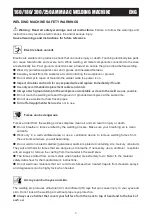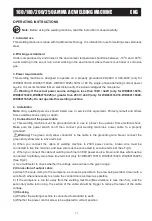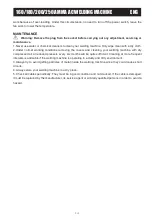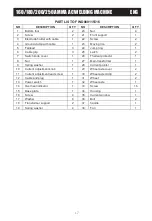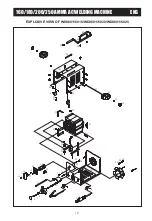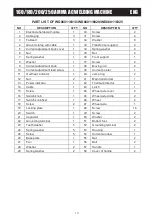
160/180/200/250A MMA AC WELDING MACHINE ENG
eggs frying. To lay a weld bead, only 2 movements are required, downward and in the direction the weld
is to be laid (See Fig 8).
5) Types of weld bead
The following paragraphs discuss the most commonly used arc welding beads.
a) The stringer bead formed by traveling with the electrode in a straight line while keeping the electrode
centered over the weld joint (See Fig 9).
b) The weave bead used when you want to deposit metal over a wider space than would be possible with
a stringer bead. It is made by weaving from side to side while moving with the electrode. It is best to
hesitate momentarily at each side before weaving back the other way (See Fig 10).
6) Welding position
a) Flat position it is easiest of the welding positions and is most commonly used. It is best if you can weld
in the flat position if at all possible as good results are easier to achieve (See Fig 11).
b) The horizontal position it is performed very much the same as the flat weld except that the angle is
different such that the electrode, and therefore the arc force, is directed more toward the metal above the
weld joint. This more direct angle helps prevent the weld puddle from running downward while still
allowing slow enough travel speed to achieve good penetration. A good starting point for your electrode
angle is about 30 degrees down from being perpendicular to the work piece (See Fig 12).
7) Judge the good weld bead
When the trick of establishing and holding an arc has been learned, the next step is learning how to run a
good bead. The first attempts in practice will probably fall short of acceptable weld beads. Too long of an
arc will be held or the travel speed will vary from slow to fast (See Fig 13).
A. Weld speed is too fast.
B. Weld speed is too slow.
C. Arc is too long.
D. Ideal weld.
Note:
A solid weld bead requires that the electrode be moved slowly and steadily along the weld seam.
Moving the electrode rapidly or erratically will prevent proper fusion or create a lumpy, uneven bead.
Warning: Electric shock can kill! To prevent electric shock, do not perform any welding while
standing, kneeling, or lying directly on the grounded workpiece.
8) Finish the bead
As the coating on the outside of the electrode burns off, it forms an envelope of protective gases around
the weld. This prevents air from reaching the molten metal and creating an undesirable chemical reaction.
The burning coating, however, forms slag. The slag formation appears as an accumulation of dirty metal
scale on the finished weld. Slag should be removed by using a chipping hammer.
Warning: Peening the slag from a weld joint causes small chips of metal to fly through the air!
Metallic chips flying through the air can cause eye injury or injury to other parts of the head,
hands or exposed portions of the body. Wear goggles or safety glasses with side shields and
protect the hands and other exposed parts of the body with protective garments, or if possible,
work with a shield between the body and the work piece.
The intense heat produced at the arc sets up strains in the metal joined by welding. Peening the weld not
only removes the scale left behind in the welding but relieves the internal strains developed by the
heating and cooling process.
9) Allowed duty cycle
Strictly work in conformity with the required duty cycle. If work under over duty cycle, the welding machine
may suddenly stop working, and the amber overheat indicator light is lit. That's the inner thermal parts
13






